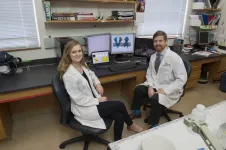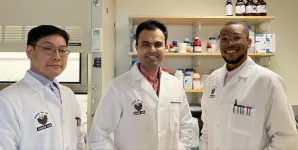(Press-News.org) RIVERSIDE, Calif. -- Supermassive black holes, or SMBHs, are black holes with masses that are several million to billion times the mass of our sun. The Milky Way hosts an SMBH with mass a few million times the solar mass. Surprisingly, astrophysical observations show that SMBHs already existed when the universe was very young. For example, a billion solar mass black holes are found when the universe was just 6% of its current age, 13.7 billion years. How do these SMBHs in the early universe originate?
A team led by a theoretical physicist at the University of California, Riverside, has come up with an explanation: a massive seed black hole that the collapse of a dark matter halo could produce.
Dark matter halo is the halo of invisible matter surrounding a galaxy or a cluster of galaxies. Although dark matter has never been detected in laboratories, physicists remain confident this mysterious matter that makes up 85% of the universe's matter exists. Were the visible matter of a galaxy not embedded in a dark matter halo, this matter would fly apart.
"Physicists are puzzled why SMBHs in the early universe, which are located in the central regions of dark matter halos, grow so massively in a short time," said Hai-Bo Yu, an associate professor of physics and astronomy at UC Riverside, who led the study that appears in Astrophysical Journal Letters. "It's like a 5-year-old child that weighs, say, 200 pounds. Such a child would astonish us all because we know the typical weight of a newborn baby and how fast this baby can grow. Where it comes to black holes, physicists have general expectations about the mass of a seed black hole and its growth rate. The presence of SMBHs suggests these general expectations have been violated, requiring new knowledge. And that's exciting."
A seed black hole is a black hole at its initial stage -- akin to the baby stage in the life of a human.
"We can think of two reasons," Yu added. "The seed -- or 'baby' -- black hole is either much more massive or it grows much faster than we thought, or both. The question that then arises is what are the physical mechanisms for producing a massive enough seed black hole or achieving a fast enough growth rate?"
"It takes time for black holes to grow massive by accreting surrounding matter," said co-author Yi-Ming Zhong, a postdoctoral researcher at the Kavli Institute for Cosmological Physics at the University of Chicago. "Our paper shows that if dark matter has self-interactions then the gravothermal collapse of a halo can lead to a massive enough seed black hole. Its growth rate would be more consistent with general expectations."
In astrophysics, a popular mechanism used to explain SMBHs is the collapse of pristine gas in protogalaxies in the early universe.
"This mechanism, however, cannot produce a massive enough seed black hole to accommodate newly observed SMBHs -- unless the seed black hole experienced an extremely fast growth rate," Yu said. "Our work provides an alternative explanation: a self-interacting dark matter halo experiences gravothermal instability and its central region collapses into a seed black hole."
The explanation Yu and his colleagues propose works in the following way:
Dark matter particles first cluster together under the influence of gravity and form a dark matter halo. During the evolution of the halo, two competing forces -- gravity and pressure -- operate. While gravity pulls dark matter particles inward, pressure pushes them outward. If dark matter particles have no self-interactions, then, as gravity pulls them toward the central halo, they become hotter, that is, they move faster, the pressure increases effectively, and they bounce back. However, in the case of self-interacting dark matter, dark matter self-interactions can transport the heat from those "hotter" particles to nearby colder ones. This makes it difficult for the dark matter particles to bounce back.
Yu explained that the central halo, which would collapse into a black hole, has angular momentum, meaning, it rotates. The self-interactions can induce viscosity, or "friction," that dissipates the angular momentum. During the collapse process, the central halo, which has a fixed mass, shrinks in radius and slows down in rotation due to viscosity. As the evolution continues, the central halo eventually collapses into a singular state: a seed black hole. This seed can grow more massive by accreting surrounding baryonic -- or visible -- matter such as gas and stars.
"The advantage of our scenario is that the mass of the seed black hole can be high since it is produced by the collapse of a dark matter halo," Yu said. "Thus, it can grow into a supermassive black hole in a relatively short timescale."
The new work is novel in that the researchers identify the importance of baryons--ordinary atomic and molecular particles -- for this idea to work.
"First, we show the presence of baryons, such as gas and stars, can significantly speed up the onset of the gravothermal collapse of a halo and a seed black hole could be created early enough," said Wei-Xiang Feng, Yu's graduate student and a co-author on the paper. "Second, we show the self-interactions can induce viscosity that dissipates the angular momentum remnant of the central halo. Third, we develop a method to examine the condition for triggering general relativistic instability of the collapsed halo, which ensures a seed black hole could form if the condition is satisfied."
Over the past decade, Yu has explored novel predictions of dark matter self-interactions and their observational consequences. His work has shown that self-interacting dark matter can provide a good explanation for the observed motion of stars and gas in galaxies.
"In many galaxies, stars and gas dominate their central regions," he said. "Thus, it's natural to ask how the presence of this baryonic matter affects the collapse process. We show it will speed up the onset of the collapse. This feature is exactly what we need to explain the origin of supermassive black holes in the early universe. The self-interactions also lead to viscosity that can dissipate angular momentum of the central halo and further help the collapse process."
INFORMATION:
The study was funded by the U.S. Department of Energy; NASA; the Kavli Institute for Cosmological Physics; and the John Templeton Foundation.
The research paper is titled "Seeding Supermassive Black Holes with Self-Interacting Dark Matter: A Unified Scenario with Baryons."
The University of California, Riverside (http://www.ucr.edu) is a doctoral research university, a living laboratory for groundbreaking exploration of issues critical to Inland Southern California, the state and communities around the world. Reflecting California's diverse culture, UCR's enrollment is more than 24,000 students. The campus opened a medical school in 2013 and has reached the heart of the Coachella Valley by way of the UCR Palm Desert Center. The campus has an annual statewide economic impact of almost $2 billion. To learn more, email news@ucr.edu.
RESEARCH TRIANGLE PARK, N.C. -- A new approach to studying conjugated polymers made it possible for an Army-funded research team to measure, for the first time, the individual molecules' mechanical and kinetic properties during polymerization reaction. The insights gained could lead to more flexible and robust soft electronic materials, such as health monitors and soft robotics.
Conjugated polymers are essentially clusters of molecules strung along a backbone that can conduct electrons and absorb light. This makes them a perfect fit for creating soft optoelectronics, such as wearable electronic devices; however, as flexible as they are, these polymers are difficult to study in bulk because they aggregate ...
DALLAS (SMU) -- A team of SMU biological scientists has confirmed that P-glycoprotein (P-gp) has the ability to remove a toxin from the brain that is associated with Alzheimer's disease.
The finding could lead to new treatments for the disease that affects nearly 6 million Americans. It was that hope that motivated lead researchers James W. McCormick and Lauren Ammerman to pursue the research as SMU graduate students after they both lost a grandmother to the disease while at SMU.
In the Alzheimer's brain, abnormal levels of amyloid-β proteins clump together to form plaques that collect between neurons and can disrupt cell function. ...
Why can some people weather the stress of social isolation better than others, and what implications does this have for their health? New research from the Communication Neuroscience Lab at the Annenberg School for Communication at the University of Pennsylvania found that people who felt a strong sense of purpose in life were less lonely during the COVID-19 pandemic. Did they achieve less loneliness by flouting public health guidance? No. Although lonelier people were less likely to want to follow public health guidance, people with a stronger sense of purpose also expressed more willingness to engage in social distancing, hand washing, and other ...
A new study looking at the way human cells activate the immune system in response to SARS-CoV-2 infection could open the door to even more effective and powerful vaccines against the coronavirus and its rapidly emerging variants keeping the global pandemic smoldering.
Researchers from Boston University's National Emerging Infectious Diseases Laboratories (NEIDL) and the Broad Institute of MIT and Harvard say it's the first real look at exactly what types of "red flags" the human body uses to enlist the help of T cells--killers sent out by the immune system to destroy infected cells. Until now, COVID vaccines have been focused on activating a different type of immune cell, B cells, which are responsible for creating antibodies. Developing vaccines to activate ...
Steroid (sex) hormones play a central role in sexual development: They help determine how boys become boys and girls become girls. If these hormones are disrupted during fetal life, it can lead to a string of reproductive disorders at birth and later in life, including malformed genitals and decreased fertility.
Many environmental chemicals are known to disrupt the hormone system and are often referred to as endocrine disrupting chemicals. Azole fungicides constitute one group that can act as endocrine disruptors. Azoles are used to combat yeast infestations in seed and food crops, but are also used in medications for humans.
Most azoles used in medicines are tightly regulated and their use is well controlled. However, some are sold over-the-counter, for ...
Philadelphia, June 16, 2021 - The SARS-CoV-2 virus that causes COVID-19 may have the ability to reactivate dormant tuberculosis (TB). In a novel study scientists END ...
In a new publication from Cardiovascular Innovations and Applications; DOI https://doi.org/10.15212/CVIA.2021.0011, Xiao-lei Yin, Dong-xue Liang, Lu Wang, Jing Qiu, Zhi-yun Yang, Jian-zeng Dong and Zhao-yuan Ma from Tsinghua University, Beijing, China; Capital Medical University, Beijing, China and The First Affiliated Hospital of Zhengzhou University, Zhengzhou, China analyse coronary angiography video interpolation methods to reduce x-ray exposure frequency based on deep learning.
Cardiac coronary angiography is a major technique that assists physicians during interventional heart surgery. Under X-ray irradiation, the physician ...
In a new publication from Cardiovascular Innovations and Applications; DOI https://doi.org/10.15212/CVIA.2021.0013, Sharen Lee, Gary Tse, Xin Wang, Adrian Baranchuk and Tong Liu from Laboratory of Cardiovascular Physiology, Hong Kong, China, Second Hospital of Tianjin Medical University, Tianjin, China and Queen's University, Kingston, Ontario, Canada consider ST-segment depression in leads I and aVL.
The 12-lead electrocardiogram (ECG) is a routinely performed test but is susceptible to misinterpretation even by experienced physicians. The authors report a case of a 72-year-old lady with no prior cardiac history presenting with atypical chest pain. Her initial electrocardiogram shows an initial ST depression followed by positive deflections leads I and aVL. ...
Commonplace pharmaceuticals, such as ibuprofen, can carry with them an inherent flaw in their atomic structure, which pairs the active, beneficial ingredient with a potentially ineffective -- or even toxic -- counterpart. New research could hold the key to more easily isolating the good while removing the unwanted.
Dr. Shoufeng Lan, assistant professor in the J. Mike Walker '66 Department of Mechanical Engineering at Texas A&M University, is leading a team investigating the use of electromagnetic control over the synthesis of chiral compounds at an atomic level -- a process that could lead to a plethora of practical ...
How do top athletes talk about doping when they themselves are using performance-enhancing drugs? Or do they just avoid the issue? A new study by the University of Göttingen reveals that any decision to use drugs almost inevitably means the decision to engage in deceptive communication such as lying or omitting information. Those using drugs, for example, regularly describe anti-doping policies as being more intense than ever or overly restrictive, play down the extent of the doping problem, or portray themselves as victims. The results were published in the European Journal for Sport and Society.
Dr Marcel Reinold, Head of Sport and Health Sociology at the Institute of Sport and Exercise Sciences at Göttingen University, analysed autobiographies of professional ...





